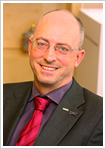Home >
Landing Page >
Lee Kuan Yew Water Prize Laureates >
Professor Mark van Loosdrecht
Professor Mark van Loosdrecht
LEE KUAN YEW WATER PRIZE 2012
Citation for Professor Mark van Loosdrecht

Short Motivation
Professor Mark van Loosdrecht was awarded the Lee Kuan Yew Water Prize 2012 for his breakthrough contributions in used water treatment, with his completely autotrophic nitrogen removal process - Anammox. The Anammox process has greatly reduced the overall energy consumption, chemical usage and carbon emissions of a conventional used water treatment plant. This was made possible by the discovery of a unique group of bacteria that removes pollutants in used water using less oxygen and no added organic carbon compared to conventional processes. By pioneering an innovative biological process that serves as a cost-effective, robust and sustainable way of removing pollutants in used water, Prof van Loosdrecht has introduced a paradigm shift in the understanding of the used water treatment process. His ground-breaking work in marrying nature and engineering has formed the basis for many variants in use today and this technology is seeing increasing adoption worldwide.
Citation
Prof Mark van Loosdrecht is awarded the Lee Kuan Yew Water Prize 2012 for his breakthrough contributions in used water treatment, with his completely autotrophic nitrogen removal process - Anammox. Prof van Loosdrecht pioneered an innovative biological process that provides a cost-effective, robust and sustainable way to remove ammonia, one of the unwanted pollutants in used water. Anammox significantly reduces the overall energy consumption, chemical usage and carbon emissions of a conventional used water treatment plant. The invention of the Anammox process was the result of almost 20 years of work and dedication by a team of microbiologists and engineers at Delft University of Technology (TU Delft) led by Prof van Loosdrecht.
At the heart of the Anammox process is a group of autotrophic bacteria that possesses a unique set of enzymes which allows them to convert ammonia to harmless nitrogen gas, which is then discharged into the environment. Unlike conventional used water treatment systems, the ammonia in used water is converted to nitrogen gas, bypassing the intermediate nitrate form. This short circuiting of the traditional nitrogen removal process, known as nitrification/denitrification, is the key to the reduction of energy consumption in used water treatment. Such energy saving technology is essential for used water treatment plants seeking energy self-sufficiency.
Though the possibility of such a shortened pathway for the conversion of ammonia to nitrogen gas had been theorised as early as the 1970s and some used water treatment facilities had for years been reporting such findings, the removal mechanism eluded investigators. In the 1990s, Prof van Loosdrecht and the TU Delft team discovered that it was possible to shorten the conventional pathway of ammonia removal in used water treatment through the development of a 2-step completely autotrophic nitrogen removal process.
When researchers at TU Delft showed that the group of bacteria responsible for this phenomenon were members of the extremely slow growing Planctomycete family, Prof van Loosdrecht and his team devised the engineering tools and systems to deliberately harness the natural properties of these unique bacteria. The first step of the process which he termed Sharon involves the use of ammonia oxidising bacteria (AOB) to oxidise half of the ammonia to nitrite instead of nitrate. Essential in this engineering is the prevention of the growth of nitrite oxidising bacteria which forms the unwanted nitrate intermediate. The second step Anammox which uses the anaerobic ammonia oxidation (anammox) bacteria to convert the nitrite and the rest of ammonia to produce nitrogen gas, without the need for added organic carbon.
Prof van Loosdrecht was instrumental in building the world's first demonstration plant using the Anammox process in Rotterdam. The world's first Anammox reactor was installed in conjunction with the Sharon plant at the Dokhaven Wastewater Treatment Plant (Rotterdam, The Netherlands) in 2002.
Conventional used water treatment is an energy intensive process. It is estimated that in most industrialised countries, the energy used in the water cycle takes up about 1% to 3% of a country's total energy budget even when the power generated by harnessing the limited biogas produced is factored in. Prof van Loosdrecht and his team are currently studying the feasibility of Anammox being applied to mainstream used water treatment processes. If successful, it will revolutionise the nitrogen removal process worldwide and its energy savings will be enormous.
Prof van Loosdrecht has dedicated his career to pushing the boundaries and challenging the paradigms in used water treatment. Prof van Loosdrecht's paradigm shifting work in marrying nature and engineering is now the basis for many variants used today and gaining worldwide adoption.
As of January 2012, there are 16 referenced full-scale Anammox plants implemented by Paques (licensee of Prof van Loosdrecht's technology) and more than 30 full-scale variant plants in Netherlands, Austria, China, Japan and USA in operation around the world. Singapore is currently conducting a pilot trial of the anaerobic ammonia oxidation process at its water reclamation plant and this has shown positive results. National water agency PUB is looking into the adoption of this technology to improve energy efficiency.
Aside from Anammox, Prof van Loosdrecht is also credited with the development of Sharon, Nereda®, CANON®, BABE®, BCFS® and SANI®, working closely with a variety of Dutch companies.
About Prof Mark van Loosdrecht
Prof van Loosdrecht is currently a full Professor and the Group Leader of Environmental Technology at TU Delft. He did his Masters of Science in Environmental Engineering at Wageningen University and obtained his PhD in Microbiology/Colloid Chemistry at the same university in 1988. He has been lecturing at TU Delft since 1988.
His research interests include biofilm and granular sludge systems, microbial storage polymers, nutrient removal processes and microbial ecology of engineered systems. He is also developing a start-up company, BiAqua, based on ferritin technology, and addressing the process of converting waste into chemicals.
